RBI has finally given the ‘bad bank’ the green signal. The essence of the altered arrangement is a principal-agent relationship between the National Asset Reconstruction Company (NARCL) and the India Debt Resolution Company (IDRCL) under which an entity legally appoints another entity to act on its behalf. The NARCL will acquire and aggregate the NPA accounts from banks while the IDRCL will take care of the debt resolution process; final approvals and ownership for the resolution shall lie with NARCL as the principal. The state-owned lenders hold a majority stake in NARCL while the private-sector lenders own a majority stake in the IDRCL.
The earlier structure—an ARC working in tandem with an asset management company (AMC)—was announced in the Union Budget for 2021-22, but the regulator had expressed its reservations. That had its origins in a framework called Sashakt which envisaged setting up an AMC along with multiple alternative investment funds (AIFs) to handle assets from different sectors. Apparently, the IBA changed tack in favour of an ARC-based system because a pure AMC structure was thought to be a less-than-ideal mechanism to aggregate loan exposures to a single asset held by different banks.
However, ARCs, being a category of non-banking financial companies (NBFCs), are regulated by the RBI, while AMCs come under the purview of the Securities and Exchange Board of India (SEBI). So RBI approved an ARC licence for the NARCL, but was unhappy with the dual structure. The bad bank was always a bad idea because of the moral hazard it creates. But now that the back-and-forth has ended, banks must get a move on and be better prepared to manage the moving parts involved in running it than they were while setting it up. Stressed assets worth some Rs 2 lakh crore are awaiting resolution and losing value with each passing day; assets worth Rs 50,000 crore are expected to be transferred to NARCL in the current fiscal. These assets are to be acquired on a 15:85 Cash:SR structure.
Even though the Centre has heavily capitalised PSU banks over the last three years, which helped the latter provide for loan losses, it again generously provided `30,600 crore as a guarantee for the SRs; this will be used to cover the shortfall between the face value of the SR and the actual amount realised. The guarantees impart liquidity to the SRs which are tradeable. Given the assets have been fully provided for, banks really have little to lose. Indeed, it should have been possible for banks to sell the aggregated assets—in the NARCL—to any ARC as that might have fetched them a better price. However, as experts point out, ARCs may be reluctant to take on large legacy assets. How well and how soon the stressed assets are resolved will determine the efficiency of this mechanism.
Given that most of assets are quite old, and buyers will not be easy to come by, there is the risk of the bad bank becoming a warehouse for stressed loans.
Analysts point out that if the initial cash receipts are more or less equivalent to the amount invested by banks, it would amount to simply shifting the problem from one place to another.
Time is of essence and bankers will likely work hard to get the assets resolved because the backstop arrangement is valid for five years only; the guarantee can be invoked either if the asset is resolved or liquidated. After all this support, it would be a pity if this much-delayed grand scheme fails to deliver.


